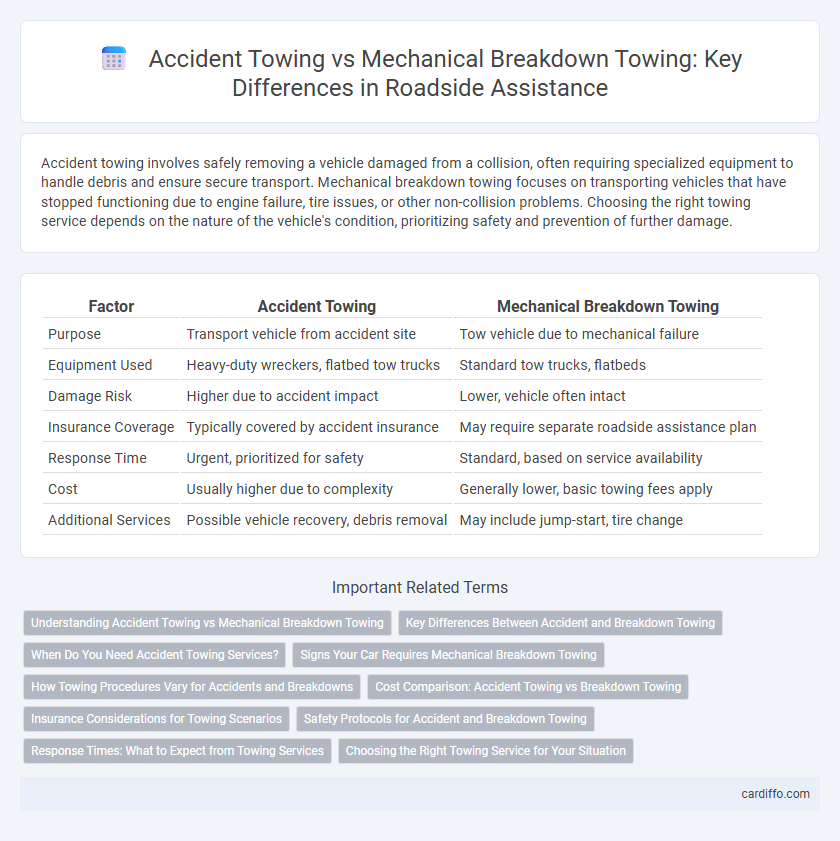Accident towing involves safely removing a vehicle damaged from a collision, often requiring specialized equipment to handle debris and ensure secure transport. Mechanical breakdown towing focuses on transporting vehicles that have stopped functioning due to engine failure, tire issues, or other non-collision problems. Choosing the right towing service depends on the nature of the vehicle's condition, prioritizing safety and prevention of further damage.
Table of Comparison
| Factor | Accident Towing | Mechanical Breakdown Towing |
|---|---|---|
| Purpose | Transport vehicle from accident site | Tow vehicle due to mechanical failure |
| Equipment Used | Heavy-duty wreckers, flatbed tow trucks | Standard tow trucks, flatbeds |
| Damage Risk | Higher due to accident impact | Lower, vehicle often intact |
| Insurance Coverage | Typically covered by accident insurance | May require separate roadside assistance plan |
| Response Time | Urgent, prioritized for safety | Standard, based on service availability |
| Cost | Usually higher due to complexity | Generally lower, basic towing fees apply |
| Additional Services | Possible vehicle recovery, debris removal | May include jump-start, tire change |
Understanding Accident Towing vs Mechanical Breakdown Towing
Accident towing involves recovering vehicles from crash scenes, often requiring specialized equipment to handle damaged or unsafe cars, ensuring safe transport to repair facilities or impound lots. Mechanical breakdown towing deals with vehicles immobilized due to engine failure, battery issues, or other mechanical problems, typically requiring flatbed or dolly tow trucks to prevent further damage during transit. Understanding these distinctions helps determine the appropriate towing service, optimizing vehicle safety and efficiency in roadside assistance.
Key Differences Between Accident and Breakdown Towing
Accident towing involves the removal of vehicles damaged in collisions or crashes, often requiring specialized equipment like winches and flatbed trucks to handle structurally compromised vehicles safely. Mechanical breakdown towing typically deals with operational failures such as engine troubles or flat tires, where standard tow trucks or dolly systems are sufficient to transport the vehicle without additional safety concerns. The primary distinction lies in the severity of vehicle condition and the towing approach, with accident towing demanding more precaution and specialized handling compared to routine mechanical breakdown towing.
When Do You Need Accident Towing Services?
Accident towing services are essential when a vehicle is involved in a collision causing significant damage that renders it undrivable or unsafe to operate. These services prioritize careful handling to avoid further damage and often require specialized equipment to manage wreckage or debris from the accident scene. Mechanical breakdown towing, by contrast, is needed for non-accident situations where the vehicle cannot move due to engine failure or other mechanical issues without structural damage.
Signs Your Car Requires Mechanical Breakdown Towing
Warning signs your vehicle needs mechanical breakdown towing include persistent engine overheating, unusual noises such as grinding or knocking, and sudden loss of power. Dashboard indicators like the check engine light or oil pressure warning signal imminent mechanical failure. Ignoring these symptoms increases the risk of severe engine damage, making professional mechanical breakdown towing essential for safe and efficient vehicle recovery.
How Towing Procedures Vary for Accidents and Breakdowns
Towing procedures for accident vehicles prioritize securing the scene and assessing damage before vehicle removal, often involving law enforcement and insurance documentation. In contrast, mechanical breakdown towing focuses on safe vehicle extraction without extensive damage inspection, using techniques like flatbed or wheel-lift towing to prevent further mechanical issues. Safety protocols and equipment differ to address the unique risks presented by collision damage versus vehicle immobilization.
Cost Comparison: Accident Towing vs Breakdown Towing
Accident towing typically incurs higher costs due to the need for specialized equipment, such as flatbed trucks and winches, along with increased labor for safe vehicle recovery and potential involvement of insurance processes. Breakdown towing usually involves simpler, quicker service with standard tow trucks, resulting in lower fees often based on distance to the repair shop. Understanding these cost differences helps vehicle owners budget appropriately for roadside assistance following accidents or mechanical failures.
Insurance Considerations for Towing Scenarios
Insurance considerations for accident towing often involve comprehensive coverage policies that include collision and liability protections, ensuring coverage for damages and third-party claims. Mechanical breakdown towing typically falls under roadside assistance or mechanical breakdown insurance plans, which cover labor and towing services due to vehicle malfunctions without fault attribution. Policyholders should review their insurance documents carefully to understand coverage limits, deductibles, and any exclusions related to towing scenarios.
Safety Protocols for Accident and Breakdown Towing
Safety protocols for accident towing prioritize securing the accident scene with reflective warning signs, proper vehicle stabilization, and coordination with emergency services to prevent secondary collisions. Mechanical breakdown towing emphasizes the safe loading and securing of the disabled vehicle using winches or flatbeds while ensuring clear communication between the operator and driver to avoid hazards. Both towing types require adherence to traffic regulations, use of personal protective equipment (PPE), and continuous situational awareness to protect operators and other road users.
Response Times: What to Expect from Towing Services
Accident towing services typically have longer response times due to the need for scene assessment, coordination with emergency responders, and potential traffic control, often ranging from 30 to 60 minutes. Mechanical breakdown towing usually offers faster arrival, averaging 15 to 30 minutes, as dispatch centers prioritize quick assistance to minimize driver inconvenience. Understanding these differences helps set realistic expectations for roadside assistance and ensures timely vehicle recovery based on the situation's severity.
Choosing the Right Towing Service for Your Situation
Accident towing services specialize in safely transporting vehicles involved in collisions, often requiring equipment for heavy-duty recovery and damage assessment. Mechanical breakdown towing focuses on relocating vehicles that have stalled due to engine failure or other mechanical issues, typically requiring less specialized equipment. Selecting the appropriate towing service ensures timely and damage-free transport, minimizing further complications and expenses.
accident towing vs mechanical breakdown towing Infographic

 cardiffo.com
cardiffo.com